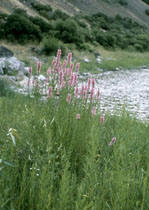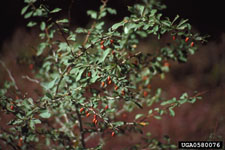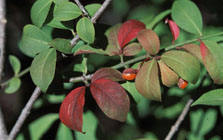|
Invasive plants, Part II
Mary Ann Ryan
Adams County Master Gardener
 Some time ago Master Gardener Frank Williams wrote about invasive plants; why
they are a problem, and why we, as neighbors and gardeners need to care. Some time ago Master Gardener Frank Williams wrote about invasive plants; why
they are a problem, and why we, as neighbors and gardeners need to care.
|

Purple Loosestrife
Lythrum salicaria |
How often Iíve heard "itís not invasive in my garden" or "I havenít seen it escape into my neighborhood!" But do we see the seeds of a purple loosestrife blow away? Where does it go? That seed will settle in a location far from our eyes, and away
from our home. Where has the wind taken that seed? Where had the seed drifted through the rain gutters to stop in some swampy or wet area, just perfect for germination? Then that seed turns into a healthy plant, pretty as it may be, and itís roots begin to spread -
spreading to the point that it becomes "aggressive", taking over native plants that are naturally controlled by our native predators, whether it be insects, rodents, ducks or other wildlife, feeding on the seeds or plant parts of those native species.
|

Japanese barberry
Berberis thunbergii DC
|
|

Burning Bush
Euonymus alata
|
Many of us have heard about lythrum, or purple loosestrife. We know how it has take over our wetlands in New England and is threatening them here in our state. But did we know about the Japanese Barberry - Berberis thunbergii, common privet -
Ligustrum vulgare, Maiden Grass - Miscanthus sinensis, and Burning bush - Euonymus alatus? None of these plants have been or are illegal to sell in our state, but PA has listed then on the invasive plant list. Why? Because they are now found in our woodlands, in our
meadows, and along the edges of forests, degrading our natural habitats.
Japanese barberry, Berberis thunbergii, is commonly sold in the nursery industry. This plant is native to southern Europe to central China. It is very easily propagated from seed and very adaptable to many growing conditions. The seeds of some of the
selected varieties of the species, such as Crimson Pygmy, tend to revert back to the straight B. thunbergii, making it a plant you do not want in your landscape. Replace this plant with Itea virginica, or sweetspire. This native plant offers a beautiful red fall color and
has drooping white flowers in the spring. Selected varieties are available at local nurseries.
Common privet, Ligustrum vulgare, is an old time hedge plant, used extensively in the 50ís and 60ís. This is a deciduous plant, native to Europe and northern Africa. Often times it can be purchased as a bare-root plant in bundles of 10-25, making it
a very inexpensive hedge material. However, it reseeds, showing up in places it doesnít belong.
What could you replace it with? One choice is northern Bayberry, Myrica pennsylvanica. This is a native shrub, holding its leaves through the winter, but turning brown in exposed locations, and sometimes dying back. This plant will get 8 feet tall,
and create a beautiful summer hedge.
Maiden Grass, Miscanthus sinensis, is a very popular ornamental grass grown for its beautiful plumes. However, the seeds blow with the wind, taking hold on forestsí edges.
This grass can be substituted with native switch grass, Panicum virgatum, a 5 foot grass with lovely foliage and interesting seed heads. Many new varieties of this species with interesting foliage are being introduced in the industry and readily
available.
Burning bush, Euonymus alatus, shows a beautiful red fall color, difficult to equal with any other plant. This shrub will easily reach 5 ft tall and wide, often times larger, and is used as a fall specimen plant or a hedge. This shrub has been
reseeding in filtered shaded areas and full sun throughout PA. This shrub is native to Northeastern Asia to central China. A good substitution: Smooth sumac, Rhus glabra. This native plant gets a beautiful red fall color and adds additional interest with its red fruit. The
industry has been cultivating this plant, making selections that are stunning. This plant is becoming more available in the nurseries and garden centers in our area.
As we become more familiar with the invasives, we can make educated decisions about what plants we choose to plant in our own gardens and landscapes. As you see from the few listed here, invasive plants are not just weeds. Often they are shrubs and
trees that we have been planting for years. Pushing the plant industry to sell the plants that we want will encourage new selections and varieties of our native plants. Ask your garden center or nursery for native and non-invasive plants.
For the sake of your neighborhood, your environment, and your world, we need to become familiar with unwanted plants. Check out http://www.dcnr.state.pa.us/forestry/wildplant/invasive.aspx for other invasive plant species.
Read other articles on ecological gardening & native plants
Read other articles by Mary Ann Ryan |